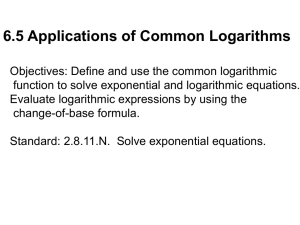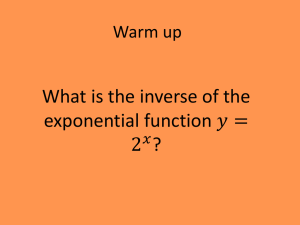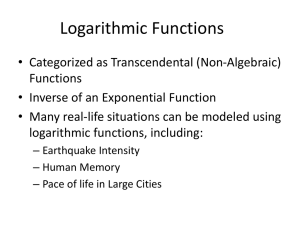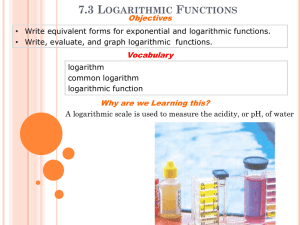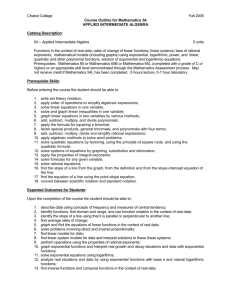Laws of Exponents
advertisement
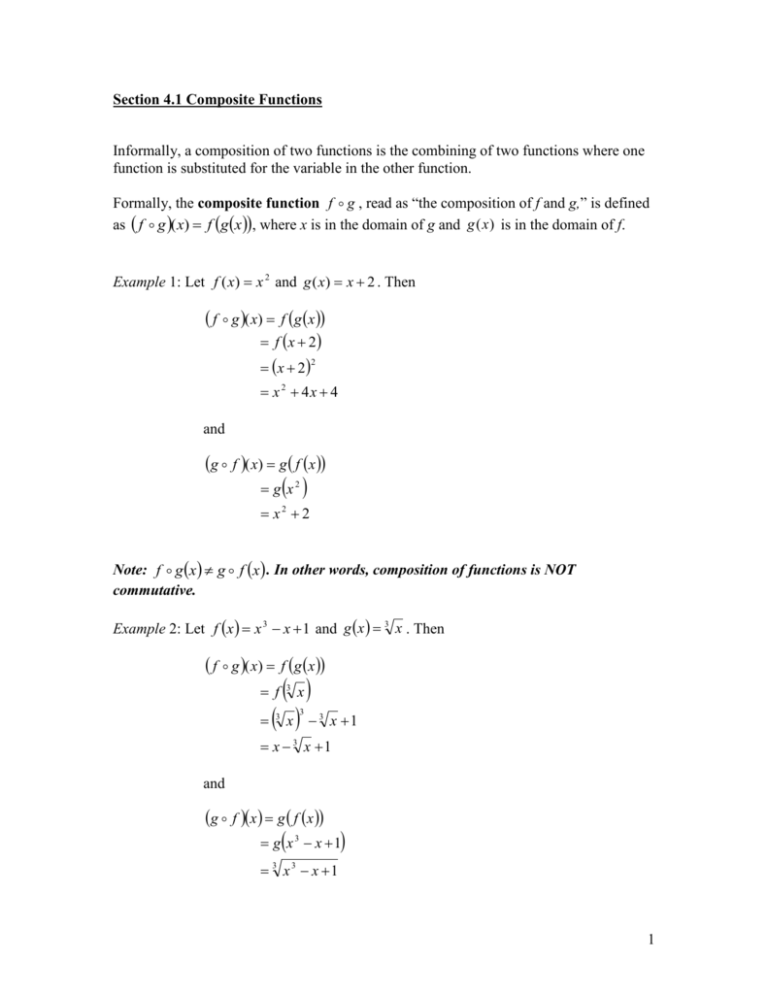
Section 4.1 Composite Functions Informally, a composition of two functions is the combining of two functions where one function is substituted for the variable in the other function. Formally, the composite function f g , read as “the composition of f and g,” is defined as f g ( x) f g x, where x is in the domain of g and g (x ) is in the domain of f. Example 1: Let f ( x) x 2 and g ( x) x 2 . Then f g ( x) f g x f x 2 2 x 2 x 2 4x 4 and g f ( x) g f x g x2 x2 2 Note: f g x g f x . In other words, composition of functions is NOT commutative. Example 2: Let f x x 3 x 1 and g x 3 x . Then f g ( x) f g x x x f 3 3 3 3 x 1 x 3 x 1 and g f x g f x g x3 x 1 3 x 3 x 1 1 Section 4.2 One-to-One Functions; Inverse Functions Recall, that a function can be defined as an arrow diagram, a set of ordered pairs, or as an equation. Given a function defined as a set of ordered pairs, f x, y , the inverse function is the set of ordered pairs f 1 y, x . The inverse of a function may or may not be another function. If the inverse of a function is also a function, then the function is said to be a one-to-one function. Determining When a Function Is Also a One-to-One Function For an arrow diagram, a function is also one-ton-one if each element in the range has only one arrow leading back to one element in the domain. For a set of ordered pairs, check the second element in each ordered pair. If its value is repeated and their first elements are different, then the function is not one-to-one. For a function that has been graphed, perform the Horizontal Line Test. (If you can draw a horizontal line through any part of the graph and intersect it more than once it is not a one-to-one function.) Definition Let f denote a one-to-one function. The inverse of f, denoted by f 1 , is a function such that f 1 f x x for every x in the domain of f and f f 1 x x for every x in the domain of f 1 . Graphs of a function and its inverse When you graph the function f and its inverse function f –1 on the same coordinate plane, along with the line y = x, we find that we obtain a mirror image on both sides of the line y = x. Hence the line y = x is called the line of symmetry. To graph a function and its inverse 1. Draw in the line of symmetry, y x with a dashed line. 2. Create a table of values x, y that represent solutions of the function f x , plot them and draw a smooth curve through these points. This is the graph of f x . 3. Plot the points y, x , which are solutions of the function f 1 x , and draw a smooth curve through these points. This is the graph of f 1 x . 2 We can find the inverse of a function algebraically. To find the inverse of a function f (x): Replace f (x) with y. Interchange x and y. Solve the resulting equation for y. Replace y with f –1(x). Example: Find the inverse function of f x 2 x 3 y 2x 3 x 2y 3 x3 y 2 x3 f 1 x 2 3 Section 4.3 Exponential Functions Exponential Expressions An exponential expression is an expression that has a base and an exponent – baseexponent. The base can be a constant, variable, or algebraic expression. When the exponent is a positive integer, we can evaluate the expression by writing it in expanded form and using repeated multiplication. The base is repeated as a factor for the number of times represented by the exponent. Laws of Exponents For any base a and b and nonnegative integer exponents n and m, a n a a a a for n factors of a a a 1 a 0 1, where a 0 1 a n n , where a 0 a 1 a n , where a 0 n a a m a n a mn am a mn n a a a mn ab m a mb m m n m am a bm b a b m m bm b m a a If the exponent is not a positive integer we can use a calculator to evaluate the exponential expression. 4 Exponential Functions A function that has a term with a real number base and a variable exponent is called an exponential function. For all exponential functions of the form f ( x) a x , where a is a real number greater than 0 and a 1: The domain is the set of all real numbers. The range is all positive real numbers. The function is one-to-one. The y-intercept is (0, 1). There is no x-intercept because the x-axis is a horizontal asymptote. If a > 1, the function is always increasing. If 0< a < 1, the function is always decreasing. The function is smooth and continuous, with no corners or gaps. f x 1 The ratio a. f x There is a special number that occurs in nature and human activity so often that it was given a special symbol e, which is called the natural base. (e ≈ 2.71828…) When this irrational number e is used as the base in an exponential function it is called a natural exponential function. Example: y e x . Solving Exponential Equations There are two algebraic methods for solving exponential equations. In this section we only explore one of these methods. This method usually requires applying the Laws of Exponents and the following property below. Property of Exponential Equations If a u a v , then u v . 5 Section 4.4 Logarithmic Functions Since all exponential functions are one-to-one functions they have an inverse which is also a function. The inverse function of an exponential function is called a logarithmic function. In order to write the inverse mathematically, we define the logarithm of x with base a to be the power to which we raise a to get x. So the logarithm of x with base a is written in the form log a x and is defined as y log a x if and only if x a y , where a and x are positive real numbers and a 1 or 0. The common base of a logarithm is 10. In other words, 10 is such a common base used in a logarithmic expression that we drop the 10 from the notation when a = 10 is implied. log 10 x log x The logarithm with base e is also very common. When e is the base of a logarithm it is called a natural logarithm. Because it is also very common, we use a special notation to denote the type of logarithm. log e x ln x To evaluate a logarithm log a x , ask yourself, “What power must I raise a by to obtain x?” Sometimes the answer to a logarithm is not an integer. In this case, you can use your calculator and the change-of-base formula to evaluate the expression. Change-of-Base Formula For any positive real numbers a and x, where a 1 or 0, then log a x log x log a or log a x ln x ln a If we take the logarithm of an expression, we call the expression the argument of the logarithm. The domain of a logarithmic function is all positive real numbers. Thus, the argument must also be positive. Hence, to find the domain of a logarithmic function set its argument greater than zero and solve for the variable. The set of numbers found is the domain. 6 Given the logarithmic function f ( x) log a x and its graph, we know the following characteristics: The domain is all positive real numbers. The range is all real numbers. The function is one-to-one. There is no y-intercept. The x-intercept is (1, 0). If a > 1, then the function is always increasing. If 0 < a < 1, then the function is always decreasing. Solving Logarithmic Equations There are two algebraic methods for solving logarithmic equations. In this section we only explore one of these methods. This method requires rewriting the equation into exponential form by applying the following property below. Property of Logarithmic Equations If log a x c , where c is a constant, then x a c . More on Solving Exponential Equations We can solve exponential equations by rewriting them as a logarithmic equation using the following property. Property of Exponential Equations If a x c , where a and c are constants, then x log a c 7 Section 4.5 Properties of Logarithms For any real positive numbers a and x, where a ≠1 or 0, logarithms have the following properties: log a 1 0 because a 0 1 log a a 1 because a 1 a log a a x x because a x a x log a 1 is undefined because a > 0, which implies a n 0 , for any number n. log a 0 is undefined because a > 0, which implies a n 0 , for any number n. a loga x x (due to properties of inverses) Recall for base a and exponents m and n: a m a n a mn am a mn n a a m n a mn So, for the inverse expression: log a m n log a m log a n m log a log a m log a n n log a m c c log a m With these properties we can expand or condense a logarithmic expression. 8 Section 4.6 Solving Logarithmic and Exponential Equations A logarithmic equation in one variable is an equation with a logarithmic expression having a variable in the argument of the logarithm. An exponential equation in one variable is an equation with an exponential expression containing a variable exponent. We need the following properties of equations to solve exponential and logarithmic equations algebraically. 1. If x y , then a x a y . 2. If x y , then log a x log a y . 3. If a x a y , then x y . 4. If log a x log a y , then x y . To solve an exponential equation algebraically, you can do one of two things: Write both sides of the equation as exponential expressions with the same base, equate the exponents, and then solve for the variable. (Property 3) Isolate the exponential expression, take the logarithms of both sides of the equation, and then solve for the variable. (Property 2) To solve a logarithmic equation algebraically, you can do one of two things: Write both sides of the equations as logarithmic expressions with the same base, equate the arguments, and then solve for the variable. (Property 4) Isolate the logarithmic expression, exponentiate both sides, and then solve for the variable. (Property 1) 9 Section 4.7 Compound Interest Interest, denoted as I, is the amount of money paid for the use of someone else’s money. The total amount borrowed (whether by an individual from a bank in the form of a loan or by a bank from an individual in the form of a savings account) is called the principal and is denoted by P. The rate of interest, denoted as r and expressed as a percent, is the amount charged for the use of the principal for a given period of time, usually on a yearly basis. The total amount the lender receives after loaning the money for a period of t years is called the future value of the loan and is denoted as A. There are two general types of interest: simple and compounded. Simple interest is interest charged only on the principal. If a principal of P dollars is borrowed for a period of t years at an annual interest rate r, expressed as a decimal, the interest I charged is I Pr t . The future value of the loan is A P Pr t P1 rt . When the interest due at the end of a payment period is added to the principal so that the interest computed at the end of the next payment period is based on this new principal amount (old principal + interest), the interest is said to have been compounded. Compound interest is interest paid on previously earned interest. If the interest is nt r compounded n times a year, then the future value of the loan is A P1 . n What happens if the number n of times that the interest is compounded gets larger and larger; that is, suppose that n . Then rt 1 r A P1 P 1 n n r nt nt n 1 r P 1 . As n , n r n 1 r 1 e. n r Hence, for continuously compounded interest the future value of the loan is A Pe rt . The effective rate of interest is the equivalent annual simple rate of interest that would yield the same amount as compounding after 1 year. The present value of A dollars to be received at a future date is the principal that you would need to invest now so that it will grow to A dollars in the specified time period. The formulas for present value are as follows. For compounding n times a year r P A1 n nt and for compounding continuously P Ae rt . 10 Section 4.8 Exponential Growth and Decay Exponential Growth Some objects grow at an exponential rate such as bacteria or cells. We can represent this type of growth with two different exponential functions. Let A0 represent the original amount of material, r be the percentage of increase over a period of time, and t represent the time the material has been growing. (Note: r and t have to have the same units of time.) Then the amount, A, of the material after time t is: At A0 1 r A0 e kt , where k ln 1 r and is called the growth rate. t Exponential Decay All radioactive substances have a specific half-life, which is the time required for half of the radioactive substance to decay. This type of decay follows an exponential function. There are two different exponential functions which can be used to calculate the amount of substance remaining after a period of time. Let A0 represent the original amount of radioactive material, h be the half-life of the material, and t represent the time the material has been decaying. (Note: h and t have to have the same units of time.) Then the amount, A, of the material remaining after time t is: t ln 2 1h and is called the rate of decay. At A0 A0 e kt , where k h 2 Other Applications The pH of a substance is defined by the function pH log H where H is the hydrogen concentration in moles per liter. Pure water has a pH value of 7.0. A pH value greater than 7.0 represents an alkaline substance. A pH value less than 7.0 represents an acidic substance. Newton’s Law of Cooling states that the temperature of a heated object decreases exponentially over time toward the temperature of the surrounding medium. That is, u t T u 0 T e kt for k 0 , where T is the constant temperature of the surrounding medium, u 0 is the initial temperature of the heated object, and k is a negative constant. 11


